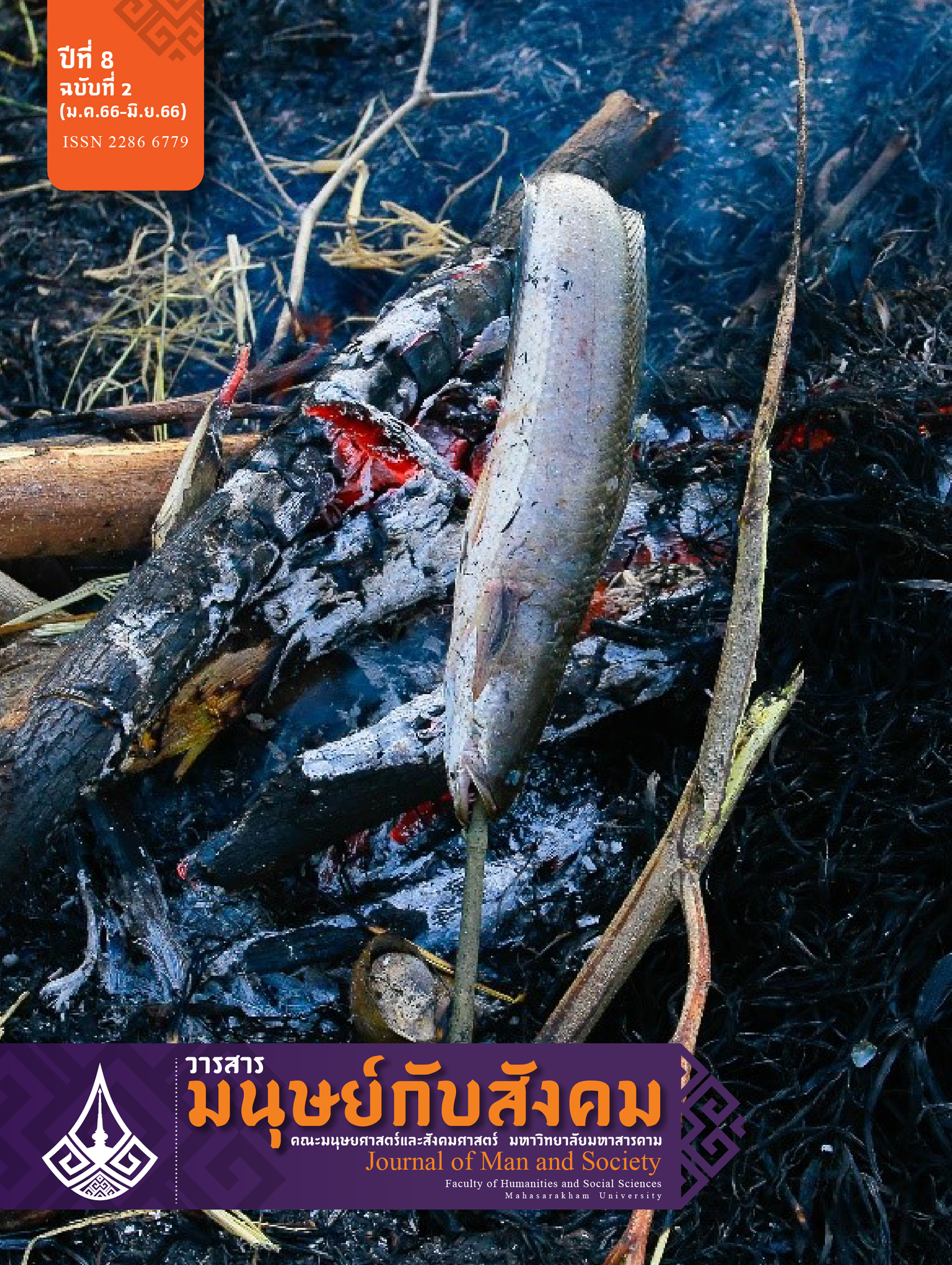The Community’s Participation in the Development of the Traditional Cloth Weaving Wisdom for Communal Innovation according to the Creative Economy: A Case Study of the Bru Community of Ban Talong, Tambon Huaypai of Khong Chiam, Ubon Ratchathani Province
Main Article Content
Abstract
The research aimed to study the community’s participation in developing traditional cloth-weaving wisdom of Ban Talong’s Bru people of Tambon Huaypai in Khong Chiam district, Ubon Ratchathani and explore the guidelines for the development of the cloth-weaving innovation of the people under study. The work was qualitative research and employed the concepts derived from creative economy. The research instruments included an in-depth interview and a participatory and non-participatory interview record. Twenty target groups used in the research were the folk scholars, the community leaders and the traditional cloth weaving group. The research findings were as follows. Concerning the community’s participation in developing the traditional cloth-weaving wisdom of the Bru group of Ban Talong, it was found that the participation process could be categorized into five steps: 1) surveying the cloth-weaving traditions, 2) organizing the public forum to obtain relevant ideas, 3) training on the weaving and sewing skills for the locals, 4) the community’s participation in producing an innovation related to the Bru group’s cloth weaving knowledge, and 5) the forum to return local knowledge to the community. As regards the guidelines for the development of the innovation related to the traditional cloth weaving of the Bru residents of Ban Talong, the guidelines were divided into three ways: 1) providing more equipment and tools to increase the production potential and quality products, 2) training on the industrial sewing machine skills, and on producing and processing the traditional cloths into a variety of products under the guidelines of the creative economy and 3) making the model products from the traditional woven cloths to maintain the identity of the Bru people. The products were divided into two types. One was the hat products which were tulip-shaped and flower-shaped. The other was the bag products, which had circular, elongated and square shapes.
Article Details

This work is licensed under a Creative Commons Attribution-NonCommercial-NoDerivatives 4.0 International License.
เนื้อหาและข้อมูลที่ตีพิมพ์ลงในวารสารมนุษย์กับสังคม ถือเป็นข้อคิดเห็นและความรับผิดชอบโดยตรงของผู้เขียนซึ่งกองบรรณาธิการวารสารไม่จำเป็นต้องเห็นด้วยหรือร่วมรับผิดชอบใดๆ
บทความ ข้อมูล เนื้อหา รูปภาพ ฯลฯ ที่ได้รับการตีพิมพ์ในวารสารมนุษย์กับสังคม ถือเป็นลิขสิทธิ์ของวารสาร หากบุคคลหรือหน่วยงานใดต้องการนำทั้งหมดหรือส่วนหนึ่งส่วนใดไปเผยแพร่ต่อต้องอ้างอิงวาสาร
References
กอบชัย รัฐอุบล และ มานิตย์ โศกค้อ. (2560). เรื่องเล่า ประวัติศาสตร์ท้องถิ่นกับการสร้างพลังชุมชนของชาวบรูบ้านท่าล้งและบ้านเวินบึก อำเภอโขงเจียม จังหวัดอุบลราชธานี. วารสารมนุษยศาสตร์และสังคมศาสตร์ มหาวิทยาลัยราชภัฏอุบลราชธานี, 8(ฉบับพิเศษ): 463-480.
จิตรกร โพธิ์งาม. (2536). โลกทัศน์ของชาวบรู บ้านเวินบึก อำเภอโขงเจียม จังหวัดอุบลราชธานี. [วิทยานิพนธ์ศิลปศาสตรมหาบัณฑิต สาขาวิชาไทศึกษา, คณะมนุษยศาสตร์และสังคมศาสตร์ มหาวิทยาลัยมหาสารคาม].
จุรีวรรณ จันพลา และคณะ. (2559). การพัฒนารูปแบบผลิตภัณฑ์ผ้าทอไทยทรงดำ เพื่อสร้างมูลค่าเพิ่มตามแนวทางเศรษฐกิจสร้างสรรค์. Veridian E-Journal Silpakorn University, 9(2): 82-98.
ชาญวิทย์ เกษตรศิริ. (2553). แม่น้ำโขง: จากต้าจู-ล้านช้าง-ตนเลธม ถึงกิ๋วล่อง (พิมพ์ครั้งที่ 2). กรุงเทพฯ: มูลนิธิโครงการตำราสังคมศาสตร์และมนุษยศาสตร์.
ปฐม หงษ์สุวรรณ. (2554). คติชนกับชนชาติไท. มหาสารคาม: สำนักพิมพ์มหาวิทยาลัยมหาสารคาม.
ปริตตา เฉลิมเผ่า กออนันตกูล. (2548). ภูมิปัญญาไทย-ภูมิปัญญาเทศ. กรุงเทพฯ: ศูนย์มานุษยวิทยาสิรินธร (องค์การมหาชน).
พนัส ดอกบัว. (2552). เครือญาติข้ามพรมแดนรัฐชาติของกลุ่มชาติพันธุ์บรู บ้านท่าล้ง ตำบลห้วยไผ่ อำเภอโขงเจียม จังหวัดอุบลราชธานี. [วิทยานิพนธ์ศิลปศาสตรมหาบัณฑิต สาขาวิชาสังคมศาสตร์และการพัฒนา, คณะศิลปศาสตร์ มหาวิทยาลัยอุบลราชธานี].
พงศ์ธาดา กีรติเรขา. (2562). การพัฒนาผลิตภัณฑ์ผ้าขาวม้าสู่เศรษฐกิจสร้างสรรค์: กรณีศึกษากลุ่มผ้าทอพื้นเมืองกำเนิดเพชร ตำบลเมือง อำเภอเมือง จังหวัดเลย. วารสารพัฒนาชุมชนและคุณภาพชีวิต, 7(3): 239-248.
พวงแก้ว พรพิพัฒน์. (2553). เศรษฐกิจสร้างสรรค์. วารสารเศรษฐกิจและสังคม, 47(4): 6-12.
ยุพา อุทามนตรี. (2539). ประเพณีพิธีกรรมของชาวบรูบ้านเวินบึก ตำบลโขงเจียม อำเภอโขงเจียม จังหวัดอุบลราชธานี. [วิทยานิพนธ์ศิลปศาสตรมหาบัณฑิต สาขาวิชาไทศึกษา, คณะมนุษยศาสตร์และสังคมศาสตร์ มหาวิทยาลัยมหาสารคาม].
วัฒนะ จูฑะวิภาต. (2555). ผ้าทอกับวิถีชีวิตคนไทย. กรุงเทพฯ: รายงานการวิจัย คณะศิลปกรรมศาสตร์ มหาวิทยาลัยธุรกิจบัณฑิตย์.
ศิราพร ณ ถลาง. (2543). คติชนวิทยา: จากคติชนสู่ชาวบ้านและชาวเมือง. วารสารภาษาและวรรณคดี, 17(1): 78-94.
ศิราพร ณ ถลาง. (2556). “คติชนสร้างสรรค์”: บทปริทัศน์บริบททางสังคมและแนวคิดที่เกี่ยวข้อง. วารสารอักษรศาสตร์, 42(2): 1-74.
สมใจ ศรีหล้า. (2550). กลุ่มชาติพันธุ์ข่า-บรู: การสร้างและการปรับเปลี่ยนอัตลักษณ์. วารสารสังคมลุ่มน้ำโขง, 3(1): 73-113.
สุนทร วรหาร และ มานิตย์ โศกค้อ. (2557). การมีส่วนร่วมของชุมชนในการรักษาสืบทอดวรรณกรรมพื้นบ้านของชาวบรู บ้านเวินบึก อำเภอโขงเจียม จังหวัดอุบลราชธานี. รายงานการวิจัยฉบับสมบูรณ์ สำนักงานคณะกรรมการวิจัยแห่งชาติ (วช.).
เสาวลักษณ์ อนันตศานต์. (2543). ทฤษฎีคติชนและวิธีการศึกษา. กรุงเทพฯ: สำนักพิมพ์มหาวิทยาลัยรามคำแหง.
สำนักงานคณะกรรมการพัฒนาการเศรษฐกิจและสังคมแห่งชาติ. (2552). รายงานการศึกษาเบื้องต้นเศรษฐกิจสร้างสรรค์ The creative economy, กรุงเทพฯ: บี.ซี.เพรส.
อคิน รพีพัฒน์. (2547). การมีส่วนร่วมของประชาชนในการพัฒนา. กรุงเทพฯ: ศูนย์การศึกษานโยบายสาธารณสุข.
อาคม เติมพิทยาไพสิฐ. (2553). กิจกรรมปรับกระบวนทัศน์ของประเทศสู่เศรษฐกิจสร้างสรรค์. กรุงเทพฯ: กระทรวงการต่างประเทศ.
อิษฏ์ ปักกันต์ธร. (2550). วิถีชีวิตความเชื่อในงานสถาปัตยกรรมพื้นถิ่นชาวบรู: ศึกษาเปรียบเทียบชาวบรูในพื้นที่จังหวัดหนองคาย มุกดาหาร และอุบลราชธานี. [วิทยานิพนธ์ปริญญามหาบัณฑิต สาขาวิชาสถาปัตยกรรมพื้นถิ่น, คณะสถาปัตยกรรมศาสตร์ มหาวิทยาลัยศิลปากร].
Hawkins, J. (2001). The creative economy: how people make money from ideas. London: Penguin Press.
Lisk, F. (1985). Popular Participation in Planning for Basic Needs: Concepts, Methods and Practices. Hants: Gower.


